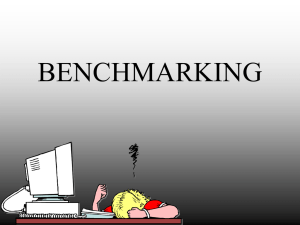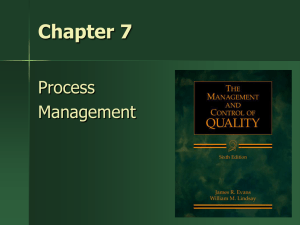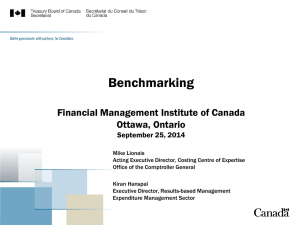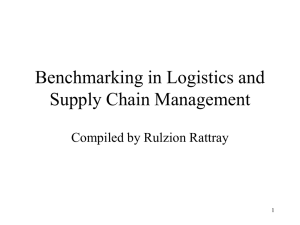Case-studies - City University of Hong Kong
advertisement
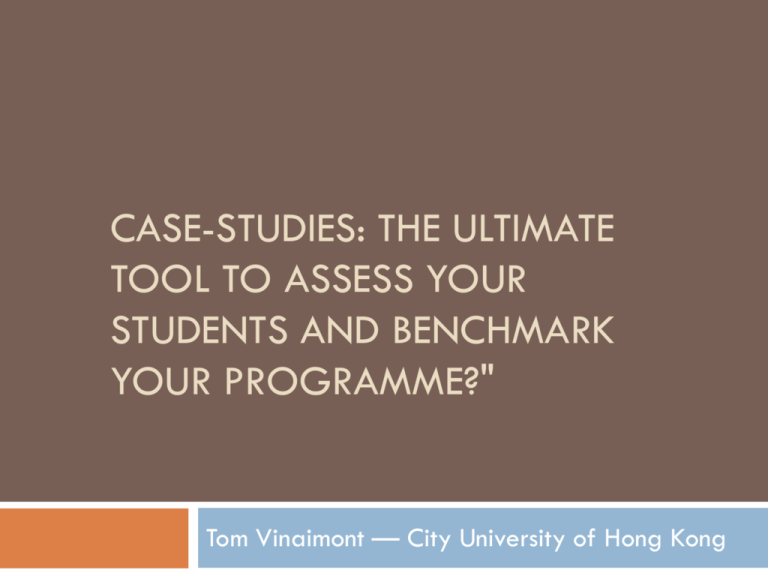
CASE-STUDIES: THE ULTIMATE TOOL TO ASSESS YOUR STUDENTS AND BENCHMARK YOUR PROGRAMME?" Tom Vinaimont — City University of Hong Kong The Link between Case Studies, Assessment and Benchmarking Case Studies (a tool) Learning Assessment Benchmarking Benchmarking: the corporate story Benchmarking, was originally invented by Rank Xerox Benchmarking is the process of comparing one's processes and performance metrics to industry bests and/or best practices from other industries. Benchmarking: What is it in common language? How well do we do compared to others? How good do we want to be? Who is doing it the best? How do they do it? How can we adapt what they do? How can we improve? How can we become the best? Benchmarking in Higher Education Benchmarking at different levels: Group of Universities Individual Universities Colleges and Departments Programs Courses Teachers Students Top-down or Bottom-up Approach Top-down Advantages: Standardization of benchmarking across the entire organization Quality control of benchmarking process Bottom-up Advantages: Organic evolution Process-oriented Relevance Closely tied to assessment Not necessarily exclusive The Use of Case Studies Learning Tool Interactive Tool Assessment Tool Benchmarking Tool Selecting your case-studies Ready-made / off-the-shelf Adaptation to local settings Starting from scratch Case Studies: A different style of learning Students need to understand that case studies are different from classic exercises: Clear set high-level learning target Real-life information Abundance of information No clearly identified issues/problems No given method to tackle the problem Not one solution Case Studies in CityU Terminology A well chosen case study corresponds directly with a Course Intended Learning Outcome (CILO) as students will do something (design, solve etc…) is itself the Teaching and Learning Activity (TLA) for that CILO is also the Assessment Task (AT) Perfect alignment! Case Studies: Learning Development of an alternative skills set: Students need to identify problems/issues themselves Students need to choose or develop a tool to tackle the problem Students need to present their problem solving strategy in a comprehensive manner Case studies: Interactivity High level task: ideal Different solutions: Ideal for group work for comparing with peers Different identification of problems/issues Ideal for discussions Case Studies: Assessment Case Studies are Assessment Task Various Assessment Options: Peer Assessment Presentation by students allows for assessment of various Learning Outcomes Interactivity with ‘lecturer’ allows for assessment of the process and assessment over time Self Assessment Case Studies: Benchmarking Benchmarking is possible on various levels with other programs who use the same case studies with the profession / professional bodies through Case Study Competitions How I use case studies Make sure students are up to par (previous courses, previous TLA should provide them with the skills and tools to tackle the case) Put students in groups Give students the story. The idea is for the students to assume the role of e.g. a CFO Give a clear high level target they need to attain Ask students to write a report How I use case studies in class (2) In class, have the students (as a group or individually) report orally with less experienced students, the lecturer can act as a moderator with more advanced students, a group can be selected to moderate the discussion Compare different problems students faced. Compare different methods students developed. Summarize the findings. How I assess the students Case Studies with clear goals: How well did the student attain the goal? Was the process to reach the goal consistent and according to best practice? How well did the students present? How well did the students work together? Other forms of assessment Peer Assessment The oral reporting gives rise to peer assessment. Students can decide who did best/worse. Self Assessment The reporting in class, provides immediate feedback to the student’s own work by the lecturer and the peer. Comparing with other’s work provides a natural framework for self-reflection and self-assessment. Practical Example: Derivatives and Risk Management Course Intended Learning Outcomes (CILOs) Upon successful completion of this course, students should be able to: 1. price basic financial derivative products 2. to use basic financial derivative products to hedge market risk 3. design strategies that alter the risk exposure of companies or institutions exposed to financial risk TLA and ATs for Derivatives and Risk Management 1 Interactive Case Study including a computer simulation used over multiple sessions Students price derivatives Students hedge risk using financial derivatives 3 Case Studies from Harvard Business School Students Walt design strategies that alter risk exposure Disney’s exposure to exchange rate risk Banc One’s exposure to exchange rate risk LTCM’s demise because of flaws in Risk Management Screenshot Interactive Case Study Practical Example: International Financial Management (I) Course Intended Learning Outcomes (CILOs) Upon successful completion of this course, students should be able to: 1. determine the impact of the firm’s international financing policy decisions on firm value 2. determine the impact of the firm’s hedging policy on firm value 3. determine the impact of the firm’s risk management policy on firm value TLAs and ATs for International Financial Management (I) 1 Interactive Case Study developed in INSEAD and used in executive training Students make production decisions, decide on the financing policy, decide on the hedging and risk management policy of the firm Students receive feedback on the value of their firm compared to the other students’ firms Screenshot Interactive Case Study Practical Example: International Financial Management (II) Course Intended Learning Outcomes (CILOs) Upon successful completion of this course, students should be able to: 1. determine the impact of cross-border mergers and acquisitions on firm value 2. determine the impact of foreign direct investment on firm value 3. evaluate international portfolio investment decisions TLAs and ATs for International Financial Management (II) Case Study on Investment Decisions and Merger/Acquisition bids of BHP, Rio Tinto and Chalco Students using financial statements and market information value the corporations in an international setting. Students calculate the impact of cross-border take-over bids. Students evaluate international portfolio decisions including political risk. Case studies the link between CLOs, TLAs, ATs and Benchmarking Case studies are developed and used at Harvard Business School and other top institutions. 1 Interactive Case Study is developed in cooperation with a market practitioner (we hope others will start using it once it is perfected) 1 Interactive Case Study is developed and used at INSEAD 1 Case Study is developed with the help of our own MBA students (we plan to publish it through e.g. Ivey Business School Case Study Center, or HKU Case Study Center) Evidence that CILOs, TLAs and ATs are meeting international (or our own) benchmarks Final Thoughts A mix of existing case studies and home-grown case-studies seems preferable Too many imported cases, while providing the opportunity to directly benchmark, kills the dynamics of a course/program. The idea is not just to attain the benchmark but to improve further. Experimenting with different tools and developing own ideas is what pushes educational quality to new heights. Therefore homegrown tools should be strongly encouraged.


